Gah I have to do this. Not for public consumption. California laws 2022 DL600 R7 2022.
Consequences
Not licensed
- If unlicensed person is drivnig your car, it maybe impounded for 30 days
- Hired to drive interstate commercially need to be older than 21, also need to be older than 21 to transport hazardous materials
Class C License
Driving #knw
- Two axle vehicle with a GVWL of 26,000 lbs or less
- Three axle vehicle weighing 6,000 lbs or less
- House car < 40 feet or less
- Three wheel motocycles
- Vanpool vehicle designed to carry between 10 and no more than 15 people
Towing #knw
- Single vehicle of 10,000 or less
- Vehicle weighing 4000 lbs or more unladen
- Trailer coach under 10,000 lbs
- Fifth wheel trailer exceeding 10,000 lbs but under 15,000 lbs, with endorsement
Mor ethings
- Class C drivers can’t tow more than one
- Motor vehile weigning under 4000 lbs cannot tow more than 6000 lbs
Getting in trouble
- Get a traffic ticket and fail to show up to court: suspend driving
- One at fault collision or one at fault traffic violation: may take action?
- Two of either at fault collision or violation conviction: no driving for 30 days unless accompanied by 25 year old adult
- Three of “”: no driving for 6 months, on probation for a year.
- Drugs or alcohol between 13-21: suspension for a year
Minor driving
Not sure if this applies
Practice for 50 hours, 10 hours at night #knw
Pass knowledge test
Pass driving test
Cannot drive between 11P and 5A during the first year #knw
Cannot drive with under 20 Y/O unless 25 Y/O licensed accompanied #knw
Unless—
- Medical need with doctor’s note and end date
- School and dean’s note
- Work and employer’s note and employment status
- Family need and parent’s note
Minors can’t use a phone while driving.
Safe car #knw
- Working driver’s window, brake lights, horn, parking brake, turn signals
- Safe tire (1/32 inch tread)
- Full windshield
- Two rear view mirrors, incl. one on left side
- Working seatbelts
Check: clean windows and mirrors, adjust seat and mirrors, check tires.
Safe personage
- Vision
- Hearing
- Not tired
- Not medicated
- Health: no
- Lapses of conciseness
- AD
- “related disorders” — anything the doctor reports to DMV
Steering
Hand to Hand
- hands 9/3 or 8/4 oclock
- Push and pull, hands stay where they are
Hand over hand
- Start 9/3 or 8/4
- Turn, but leave wheel sliding under
- Sliding under hand reach over, pull the wheel up
One-hand
- Turning or backing up to turn back
- Hand at 12 oclock
- Limeted use
Signaling
Arm signals when lights are hard to see because of bright sun

Motorcyclists use these signals, and bikers point their hand straight up to turning direction
When to signal #knw
Signal when: turn, change lanes, slow down, stop.
- 100 feet before turning
- Before every lane change: look over and check blind spot
- 5 seconds before lane change on highway
- Pulling next to or away curb
- Signal even if no cars around you
Horning
“It is safer to slow down or stop instead of honking your horn.”
When to horn #knw
- Avoid collisions
- Alert hazard
- Alert oncoming traffic on narrow mountain roads when you cannot see at least 200 feet in front of vehicle
Don’t use horn to move people along, or “express anger.” The more ya know.
Headlights
They are bright.
When to headlight #knw
- When its too dark to see: if you can’t see a person 1000 feet away
- Beginning 30 minutes after sunset until 30 minutes before sunrise
- Adverse weather: windshield wipers on = low-beam headlights on
- Clouds dust smoke or fog prevent seeing other cars
- On sunny days on country or mountain roads
- When a white regulatory sign says so
- To help others see your car, when sun is low on horizon
When not to high-beam headlight
- Dim when 500 feet of car coming towards you or 300 feet of a car you are following
Emergency flashers
If you can see a collision ahead, do:
- Turn on flashers #knw
- Lightly tap brake pedal three/four times
- Use hand signals
How to stop in a middle of the road during an emergency #knw
Start breaking early.
Give drivers warning
Turn on emergency flashers if you earn’t moving, or use turn signals
Pull off the road
Stop not on the road or, if isn’t possible, stop where people can see
Don’t stop just over a hill
Lift the hook to signal an emergency
Place emergency triangles 200-300 feet behind vehicle; use flares if needed but be careful b/c they may cause fire
Call for roadside assistance
63, 92
Lanes!
Reading ’em
Yellow: different directions
- Single yellow is the center of the road; cannot cross into oncoming traffic
- Double solid yellow line: not to be crossed
- …except
- hov entrace lane which has a left entrance
- Instructed to cross because the road is blocked
- Entering or exiting a driveway, private road, or making a u-turn
- 2 double yellow line groups spaced 2 feet or more apart are considered a barrier; under no circumstance is to cross
- …except
- Broken yellow line: you may pass if the broken line is next to you
White: same directions
- Single solid white line: traffic lanes in the same direction
- Double solid white lines: not to be crossed, regular use vs. preferential use lanes (carpool, etc.)
- Broken white lines: separate roads with two or more lines in the same direction
White triangles: yield lines
A line where you should yield. Triangles point to the direction of oncoming traffic (“towards you.”).
Choosing ’em
Leftmost lane is lane 1, rightmost is lane n
- Use the left lane to pass or turn left
- Use the right lane to enter or exit traffic
Change lanes when
- Moving from one lane to another
- Entering freeway
- Exiting freeway
- Entering the road from curb or shoulder
Protocol for lane change #knw
- Signal
- Look in all mirrors
- Check traffic beside and behind you
- Look over solder in direction of desired lane change
- Check blind spots for other vehicles, motorcyclists, and bicycilsts
- Ensure room
Tips
- stay in one lane
- don’t weave
- if you start a change, finish it
Types of them
- Lane closest to the center divider is the “passing lane”
- HOV lanes is for high occupancy
Center left turn lanes
The center of some two-way streets has a left turn lane; marked on both sides by two painted lines. Inner line is broken and outer line is solid.

You may only drive 200 feet in the center left turn lane #knw
Protocol for using this lane
- Look for other vehicles coming towards you in the center left turn lane
- Signal
- Look over shoulder
- Merge completely into the center left turn lane
- Turn when its safe.
Turnouts
Areas or lanes for turning that are marked? Use when:
- Driving slowly on a two-lane road where passing is unsafe, AND
- There are 5 or more vehicles following #knw
Bike lanes
Bike lanes
Buffered bike lanes: uses chevrons or diagonals to buffer the bikes
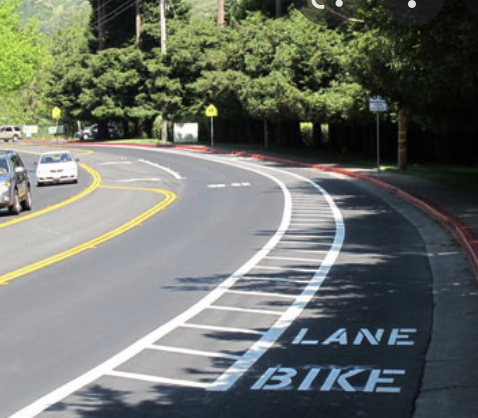
Bike route: shared road markings to designate a preferred route
Bike boulevard: bike travel on streets with cars
Seperated bikeways: completely different
Bikes share the road “sharrows!”
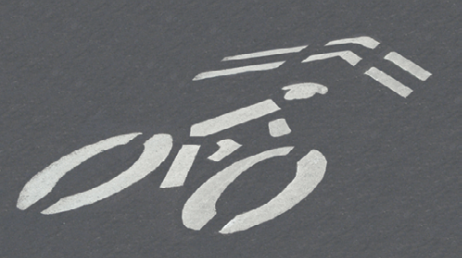
Cannot drive in bike lane unless….
- Parking
- Entering or leaving road
- Turning (within 200 feet of intersection)
Turning
Right
- Drive close to the edge
- Drive in a bike lane, wait until about 200 feet to make turn #knw
- Watch for everybody
- Signal about 100 feet before #knw
- Look over sholder
- Stop behind limit line (/before entering crosswalk or intersection)
- Look both ways and turn when its safe; don’t turn into another lane
- Complete turn
Details:
- Can’t turn when red arrow, but you can turn against red light
- You could cross a bus lane to make a right turn, but you can’t drive in it
- There could be designated right turn lanes which let you make a “free right turn”
Left
- Drive close to the center divider or left turn lane
- Signal about 100 feed
- Look over sholder
- Stop behind limit line (/before entering crosswalk or intersection)
- Look left, right, then left
- Turn
Details
- only can turn against light when single-lane-to-single-lane
U
Conditions
- Across double-yellow line
- In a residential district
- No cars for 200 feet
- Whenever a sign or light protects against approachng cars
- At an intersection
- On a divided driveway, if opening provided
Anticonditions
WHen “no u-turn” is posted
At a railroad crossing
On a divided highway if needed to cross things
Cannot see 200 feet in each direction
When other cars may hit you
On a one-way street
In front of a fire station

ooo. scary
- In business districts, including churches apartments and buildings (except for schools); turn only at an intersection or opening if allowed.
Merging
Highways
- Enter at or near traffic speed
- Merge onto highway when safe to do so, don’t stop unless needed
- Merge into a space large enough for your car to join the lane
- Use mirrors and turn signals
- Watch for cars
- Leave three seconds of space (“three second rule”) between you and the car in front of you
Exiting
- Know the exist
- Signal, look over sholder, etc.
- Change lanes
- Signal intention for 5 seconds
- Leave
Space for entering
- You will need about a half a block on city streets
- Or, a full block on the highway
Passing
If anybody wants to pass, let them pass
Space for passing
Don’t pass if…
- You are approaching a hill and cannot see oncoming traffic
- Within 100 feet of an intersection #knw
- At crossroads or driveways
Condition of Passing
You pass on the left, unless…
- Open highway with two or more lanes going in your direction
- Driver ahead of you is turning left, and you don’t have to drive off the road to pass
- You are on a one-way street
Never drive off the road to pass.
Protocol for passing
- Signal
- Shoulder
- Turn
- Speed up and pass
- Retturn
Parking
- Find a space #knw three feet longer that your vehicle
- Turn on turn signal
- Pull up alongside the vehicle in front; leave about two feet between you and the car to your right. Stop when you rear bumper is aligned with the front of the space
- Check rearview mirror, look over sholder, keep foot on break and reverse
- Back up, 45%
- When rear view is within 18 inches from the curb, straighten out
- Set parking break. Leave when safe.
Parking on a hill
“Your car may roll when you breaks fail.”
- Downhill: wheels towards the curb
- Uphill: wheels away from curb
- No curb: turn towards the sholder of the road
“towards the sholder, except when uphill with curb”
Colors
- White curb: stop for picking up or dropping off passengers or mails
- Green curb: park for limited time
- Yellow: load and unload, staying in the vehicle
- Red: no stopping
- Blue: disabled—fine of $1,000, 6 months in county jail #knw
Can’t park when
- No marking
- Unmarked or marked crosswalk
- Sidewalk, partially blocking sidewalk, or in front of driveway
- Within 3 feet of disabled sidewalk ramp #knw
- On diagnal lines next to disabled space
- Within 15 feet of a fire hydrant #knw
- Double parking
On the wrong side of the street or freeway, except: 1) emergency 2) law enforcement officer 3) specificaly permitted stop.
To stop and park then, park off the pavement, stay with the car and lock the doors until help arrives; visibility is 200 feet in each direction required. #knw
Lights
- Flashing red: stop sign–stop and go when its safe
- Flashing yellow: yield sign—proceed with caution
- Flashing yellow arrow: unprotected turn
Broken traffic lights become a four way stop sign.
Signs
- Stop sign is stop; there should be a limit line; if no limit line, stop before intesection
- Yield sign is to yield; slow down
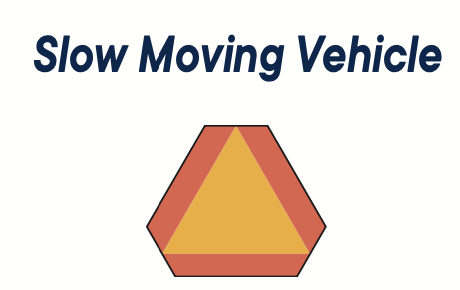
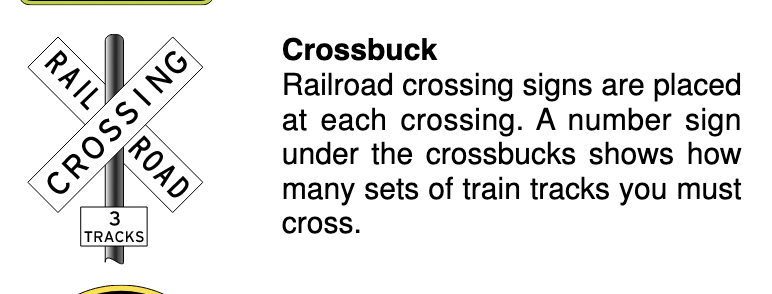
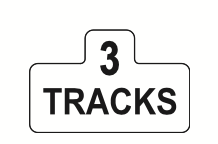

Right of Way
Without stop/yield signs
- Whomever gets to the intersection first has right of way
T intersection without stop/yield signs
- The through road have right of way
Stop signs
- Stop first, then follow right of way rules as if no intersection
Turning left
- Right of way to anyone approaching that’s “close enough to be dangerous”
Turning right
- Check for pedestrians crossing the street, and bikes and motors next to you
Green light
- Pedestrians
Divided highways
- Vehicles coming in the lane you are about to enter
Entering traffic
- The traffic you are entering
Roundabouts
The logistics of using a roundabout
- Slow down
- Yield to traffic
- Watch for signs
- Travel in counter-clockwise direction, don’t stop or pass
- Signal when you change lanes or exit
- If you miss your exit, try again
Choosing lane
- Rightmost for turning right
- Either lane (“middle”, if exists) for straight
- Innermost for left turn or u turn
Pedestrians
- Pedestrians have right-of-way
- Pedestrian crossing need to cross first, you yield or slow to them
Which means…
- Do not pass a stopped vehicle
- Don’t drive on a sidewalk except to cross it or enter/exit it
- Don’t stop in a crosswalk
- If people make eyecontact, they are crossing the street
- Obey pedestrian’s signs
Watch for seniors, people with disabilities, young children.
Crosswalks
- Crosswalks are marked (but not all)
- School crossings have yellow lines
- Pedestrians have right of wall in all crosswalks
- Flashing light crosswalks exists to, just be prepared to stop regardless
Blind
- White canes and guide dogs have absolute right of way
- Stop at all stop walks
- Don’t stop in the middle of stop walk
- Don’t give verbal directions to blind pedestrian
- Don’t turn right w/o looking for pedestrians
- Don’t honk at a blind person
- Don’t block sidewalk
- Pulling in cane + stepping away: you may go
Mountain roads
- Uphill car has right of way
- Downhill car has more control backing up the hill
Roadsharing
Large cars
- Average passenter car at 55mph has 400 feet before stopping
- Large car takes 800 feet
Don’t move in front of a large car and suddenly stop.
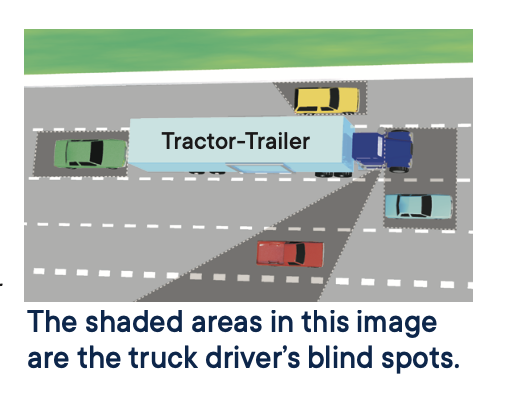
Look at turn signals: large vehicles may swing their back, say, left in order to turn right.
Don’t
- Change lanes in front of them to reach an exit or turn (tight spaces around large vehicles is dangerous)
- Drive next to them (unless passing); after you pass, move ahead of it
- Follow too closely: that’s tailgating. Give more space
- Underestimate the size and speed of the vehicle
“If you can’t see a truck’s side mirrors, it can’t see you.”
always pass it on the left side
Buses and rails
- when loading is happening without a safety zone, stop behind the nearest door
- Stopped busses can only be passed at 10mph
- Don’t pass on the left side, unless…
- you are on a one-way street
- tracks are so close to the right you can’t pass on the right
- traffic officer directs you to
- Never turn in front of a light rail vehicle
- Check for traffic lights (light rails can interrupt them)
Motocycles
- 4 second following distance
- Given a motocycle a full lane; its legal to share but its unsafe
- Don’t try to pass a motorcycle in the same lane
- When possible, move to one side of your lane
- Check for motocyclists
Emergency vehicles
- Give them right of way: drive to the edge until they’ve passed
- …except in intersections: never stop in an intersection (continue through and stop)
- Obey loudspeaker orders
- Illegal to follow 300 feet of any emergency vehicles with flashing siren
Slow cars
- Slow down for them
NEV LSV
Like gold carts
- They have max speed 25mph
- They can’t drive in roads with speed limit larger than 35 mph
Bikes
- Front lamp with white light visible for 300 feet
- Rear red reflector (visible from 500 feet)
- White or yellow reflector on each pedal (visible for 200 feet)
Travel lanes
Must ride to the curb if slow, unless
- Passing in the same direction
- Preparing to turn left
- Avoiding a hazard/road condition
- Approaching right turn
- On a one way road with two or more lanes (if so, bikers may right next to left curb)
Passing bikers
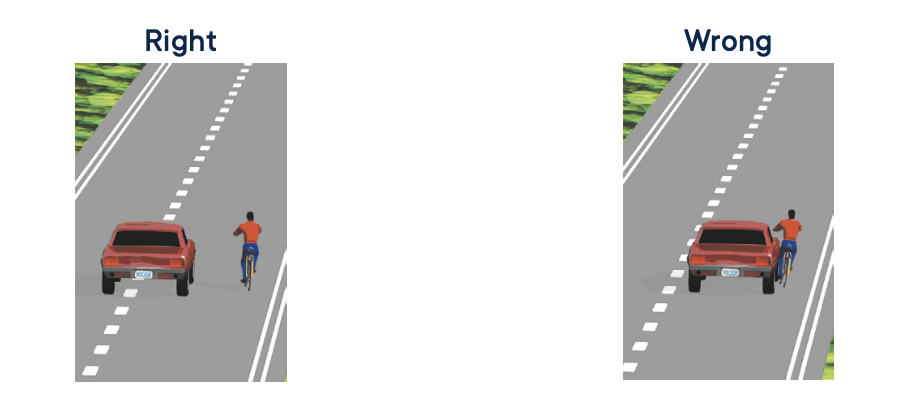
3 feet clearance
School buses
- Yellow lights flashing is to slow
- Red lights flashing is to stop
- If you fail to stop, you can be fined up to $1,000 and driving maybe suspended for a year
Workzone fines
- Traffic violations have fines of $1,000 or more
- Assulting a worker has a fine of $2,000 plus imprisonment for up to on year
- Some regions are double-fine zones
Speed Limit
“Basic speed law”: you may never drive faster than its safe.
10mph to pas a roadcar
15 mph in blind intersections (cannot see 100 in both directions when within 100 feet)
- if your view is blocked in a blind intersection, inch forward until you can see
15 mph also in some school, alleys (roads no wider 25 feet), 100 feet of railroad tracks if visiblity less then 400 feet
25 mph when you are 500-1000 feet of a school, when crossing the street, residential
55 mph on two lane undivided highway
You cannot block traffic flow
Drive far-right lane of you are towing
Railroad
- Look in both directions
- Except train anytime
- Don’t stop in traintracks
- Watch for other cars
- Stop between 15-50 feet from the neearest tracks
Fines and Stuff
Smoking with a minor: $100
Dumping animals: $1,000, six months in jail
Evading law enforcement:
- state prison up to 7 years, county jail for 1 year
- Fine between $2,000 and $10,000
- Or both
Evading law enforcement and commiting manslauter
- Imprisonment for 4-10 years
Speed content and reckless driving: fine and imprsionment
Texting
Wear earplugs in bot hyears
Carry anything that extends beyond the fenders on the left side, or more then 6 inches on the right side
Cargo more the 4 feet must display a 1 feet red or flourencesnt flag
Transport animals unless secured
Allow a person to be in a back of a pickup truck unless secured
Drive a car with a video monitor except when it doesn’t face driver
Throw a cig from the car
Cut signs that block the windshiled
Don’t hang objects on the mirror
Don’t sticker, unless
- 7 inch square on lower corner of passengers or rear window
- 5 inch square on the lower corner of the driver window
- Side windows behind driver
- 5 inch located in the center uppermost portion
Funeral pocessions have right of way
Points
- 36 month record
- Suspension when: 4 points in 12 months, 6 in 24, or 8 in 36
- Once 18 months to earn back points via traffic school
Best Practices
- Scan road 10-15 seconds ahead of you
- Don’t stare
- Don’t tailgate: 3 seconds between you and the car ahead passes
- Allow extra space when…
- If you have a tailgator, (and move! if you can)
- The driver behind you wants to pass
- Slippery
- Following on icy or wet
- Towing a trailer
- Followiing a car that blocks you ahead
- Merging onto freeway
- Following
- Allow extra space when…
- Don’t stay in the blind spot
- Don’t driving alongside cars
- Make space when possible
- Keep space between you and parked cars
- Be careful when nearing motorcyclists and bicyclists
- At intersections
- Look both ways
- Look left first (vehicles coming from the left are closer)
- Look right
- Take one more look to the left
- 5-10mph on wet road, reduce speed by half on snow, tiny very slow on ice
- Don’t use breaks if starting to hydroplone
- If you can’t see farther than 100 feet, its unsafe to drive faster than 30mph
Seat belts
- Click it or ticket
- Under 16 years old, you may also get ticket
Child safety
Under 2 years old: secure in a real facing child restraight system (unless child weighs more than 40 pounds or is more that 3 ft 4 inches taller)
Childen under 8 years old, less than 4 feet 9 inches tall: secure in a front-facing restraight system
Could use front seat if there’s no rear seat or if they are side facing jump seat
8 years old or older, or 4 feet 9 inches tall: use seat belts
6 y/o or younger unattended illegal to leave in car; supervision could be 12 year old.
Hot vehicle can kill
Emergencies
Skids
Slippery surface
- Slowly remove foot from gas pedal
- Don’t use breaks
- Turn the steering wheel in the direction of the skid
If your breaches get wet, dry them by pressing gas and brake at the same time.
Lock wheel
Breaking too hard when going to fast: skid no matter steering wheel
- Remove foot from break
- Straighten front wheel
If ABS not working, step on brake gradually until safe speed. If the brake petal sinks to the floor, bump the brakes.
Driving off pavement
- Grip wheel slowly
- Remove your foot from gas
- Brake gently
- Check for traffic
- Steer back
Accelerator mallfunction
- Shift to neutral
- Apply breakes
- Look for traffic
- Honk horn and emergency flashers
- Drive car off the road
- Turn of ignition
Collision
- If collision causes more than $1000 in property damage, you msut report to DMV
- Driving is suspended for 4 years of no insurance
Disabled Vehicle
- Safely pull over
- Exit on the right side
- Find assistance
- Return no vehicle
- Stay inside with your seat belt
- Uuse flashers
Railroad
- If a train is coming, get out and run in a 45 degree away from the train and tracks. Dial 911
- If train not coming, exit vehicle, dial emergency number on the railroad crossing box, and then call 911
DUI
- Don’t drink and drive
- Don’t take drugs
- Use any combination of drugs
Illegal to drink alcohol or smoke or eat cannabis products while in a car, whether self or passenger. If you are carrying it, it must be full and unopened. If its open, keep it in the trunk.
Limits
- 0.08% over 21
- 0.01% under 21
- 0.01% under DUI probation
- 0.04% if commercial
- 0.04% if driving for hire
DUI Arrests
- Hold license for 30 days
- Hearing from 10 days
DUI Convictions
- Completion of DUI program
- Install Ignition Interlock Device
- 6 months in jail
- $390-$1000
- May inpound vehicle
Carrying under 21
- May not carry unless someone older
- Fine up to $1000 and impound for 30 days, suspencion for 1 year
- 0.01% or higher you have to complete program, 0.05% suspension